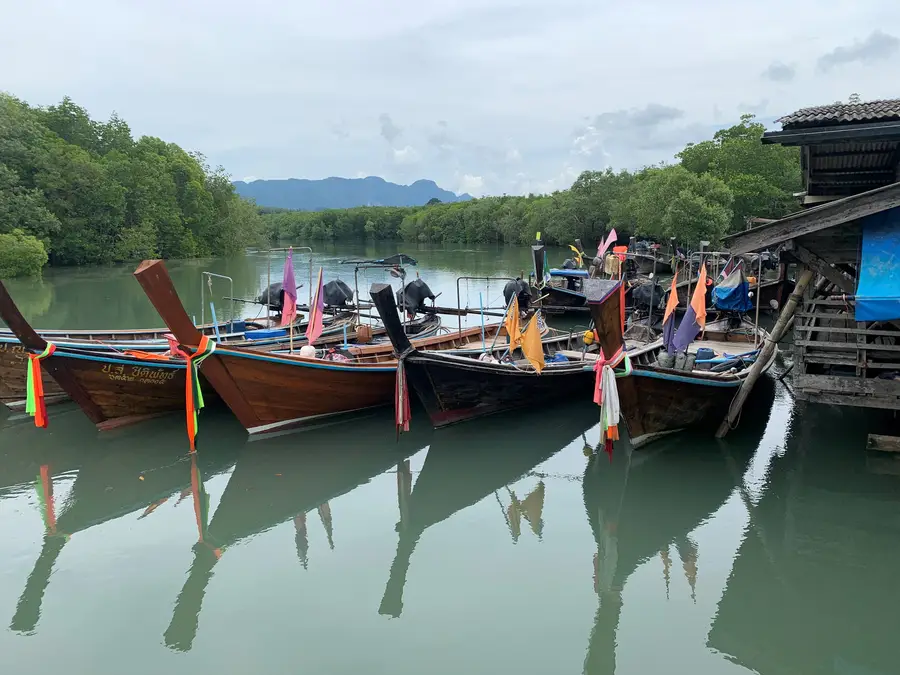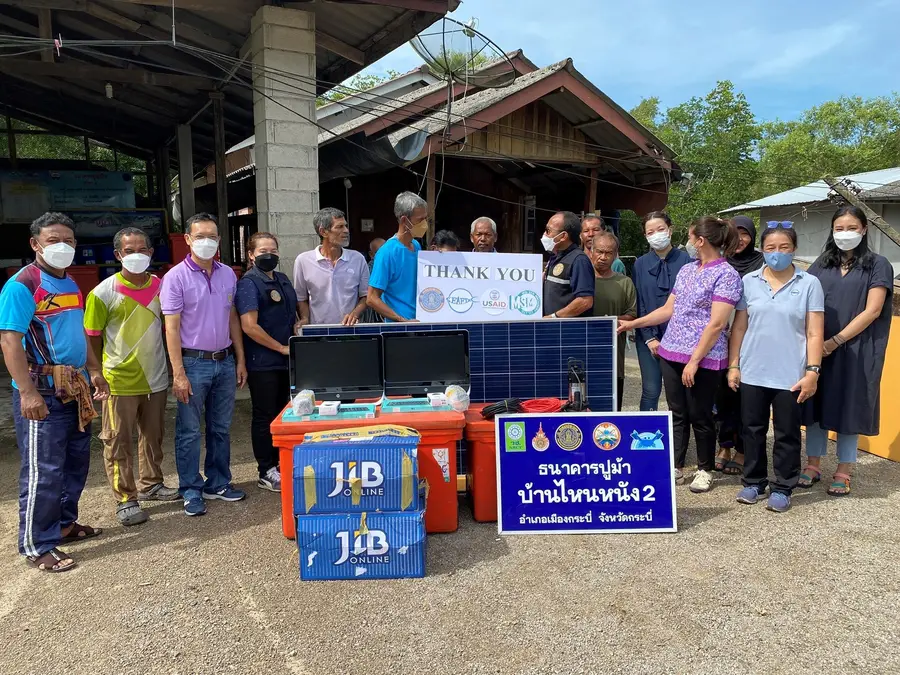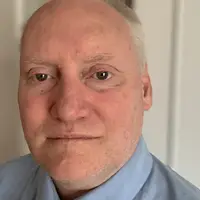
Fishing boats in Baan Nai Nang village, Krabi Province, Thailand. Photo credit: Patchareebon (Mam) Sakulpitakphon.
Patchareeboon (Mam) Sakulpitakphon spent the past two years working for RTI International as the Private Sector Engagement Specialist on the USAID Sustainable Fish Asia Local Capacity Development (SUFIA LCD) Activity. SUFIA LCD’s primary goal was to strengthen operational and technical capacity development of two regional fisheries organizations: the Southeast Asian Fisheries Development Center (SEAFDEC) and The Coral Triangle Initiative on Coral Reefs, Fisheries, and Food Security (CTI-CFF).
As the Activity draws to a close this month, Mark Granius, a governance specialist at RTI and a technical advisor on SUFIA LCD, sat down with Mam to discuss how private sector engagement (PSE) can support ecosystems approach to fisheries management (EAFM) as an established good practice in sustainable fisheries management.
How did SEAFDEC and CTI-CFF want to work with the private sector to improve regional sustainable fisheries management?
Our partners were most interested in PSE activities to combat illegal fishing, promote more sustainable fishing practices, strengthen the viability of small-scale fisheries, and protect marine biodiversity. PSE was a new approach for both organizations. They had worked with the private sector in the past through their government or strategic partners but not directly to reach these goals.
A key approach advocated and prioritized by both partners is the ecosystems approach to fisheries management (EAFM). Can you tell us more about this EAFM approach?
I admit that before working on the SUFIA LCD Activity I did not know anything about EAFM. I learned about this approach through SEAFDEC and CTI-CFF. EAFM is an integrated management approach across coastal and marine areas and their natural resources that promotes conservation and sustainable use of the whole ecosystem. While many of the coastal and marine areas are predominantly dependent on fishing, EAFM encourages these communities to diversify their economy and prioritize conservation and at the same time incorporate an “ecosystem” approach to local economic development and governance efforts.
When was the first time you saw a coastal or marine area use this EAFM approach?
Baan Nai Nang was the first community in Thailand to adopt EAFM in 2017. The community-village leaders, fishers, and local businesspeople were all involved from the beginning in developing the EAFM plan and, as a result, Baan Nai Nang has improved and diversified its economy by supporting and promoting multiple social enterprises, including small-scale seafood production of local delicacies (e.g., shrimp paste), rubber and palm oil trees, beekeeping, and ecotourism. In addition, local authorities have worked with residents to restore mangroves, improve sanitation, and promote conservation. Through the implementation of EAFM, it has also improved the relationship between local stakeholders and the Department of Fisheries in Krabi Province. The social enterprise groups within the community contribute 10% of all sales of local products to marine conservation efforts such as beach clean-ups, anti-littering campaigns, and regulatory enforcement.

Fishers and community members in Baan Nai Nang, Krabi Province. Photo credit: Krabi Department of Fisheries.
What support did SUFIA LCD provide for the EAFM approach in Baan Nai Nang?
Despite their successes, on my first visit, I also heard about their most pressing problems: they were grappling with the high cost of electricity and the fact that their business accounting was all being done by hand in bound paper ledgers.
The SUFIA LCD Activity worked with SEAFDEC and Baan Nai Nang community leaders to develop a concept note to engage companies for potential partnerships. It took nearly one year of promoting the concept note and speaking to various private sector companies in and outside of the fisheries sector to identify a partner. Eventually SUFIA LCD brokered a partnership with Min Sen Machinery Co., Ltd. (MSM) to provide the Baan Nai Nang fishing cooperative with two computers to digitalize their financial management and record keeping as well as two solar water pumps and solar cell panels for the cooperative’s crab banks*. SEAFDEC then provided support with transportation and installation of the new equipment, and training on digital logging of catch data and basic business accounting.
From the first discussions with MSM to installation of the equipment, the partnership process took five months. Through this activity, MSM learned about EAFM and the potential for expanding business in a new market and with new clients. While the SUFIA LCD Activity team provided and the initial support to get the partnership going, the implementation details were led by SEAFDEC and the Baan Nai Nang fishing cooperative.
What were the results from this PSE activity?
More streamlined processes in sustainable fisheries management
The updated digital accounting and record keeping systems will allow the fishing cooperative to efficiently record and report key catch-data to local authorities so that all stakeholders have a better understanding of the local ecosystem—types and species of the catch, the volume and frequency of the catch, crab bank data (e.g., how many crab released)— and to record market prices and track the management of their operations. The new solar powered water pump system for the crab bank will help them reduce electricity costs and improve the quality of their crab banks. These banks contribute to an increase in the local blue swimming crab population – a product that has a much higher per kilogram sale value than most caught fish.
Using electronic catch-data and traceability to impact marine biodiversity
Additionally, after our PSE and EAFM work with the Baan Nai Nang fishing cooperative, the fishers agreed to join the upcoming pilot of SEAFDEC’s electronic catch-data and traceability (e-CDT) system. The e-CDT systems will help fishers record and obtain data regarding fish caught and how these numbers impact the region’s marine biodiversity.
Promoting sustainable fisheries management with better catch limit decisions
The improved data will also help the local Department of Fisheries, in cooperation with the fishers, make better catch limit decisions based on estimated species stock in the area. This will be the first case of small-scale fishers using an e-CDT system for more sustainable fisheries management in Thailand. SEAFDEC would like to replicate this EAFM approach with small-scale fisheries (including their use of e-CDT) throughout Thailand and across the region with all its member countries.
How would you summarize your work on the SUFIA LCD Activity in trying to build private sector engagement to promote more sustainable fisheries management?
The experience of working with SEAFDEC and Baan Nai Nang fishing cooperative was eye opening for me and taught me both the challenges and the power of effective private sector partnerships for better sustainable fisheries management. It is critical to involve the real users and beneficiaries of these PSE projects from the beginning no matter the size or value of the opportunity. They will have to ultimately identify their priorities and take charge of the sustainable management of the private sector projects and investments.
Our case in Baan Nai Nang showed that small-scale fishers are willing to modernize and transition to more efficient and sustainable fishing practices, but they must prioritize their own needs and then any outside assistance provided (financial, capacity, technological) is more beneficial and sustainable.
The next big challenge in the PSE and EAFM arena will be to develop relationships and mutually beneficial partnerships between small-scale fishers and coastal communities with major national and international seafood companies.
When I was doing the Private Sector Landscape Assessment research for the SUFIA LCD Activity, companies expressed their interest in EAFM, marine conservation, and biodiversity protection. In addition, companies want international development projects with private sector engagement activities to ensure the ability to demonstrate meaningful outcomes and measurable impact. Lastly, the companies also need support to identify new partner organizations/activities for cross-sector activities and partnerships.
In conclusion, I am proud of the work we have done but also understand that momentum needs to continue to reach scale and have the larger impact to bend back the curve of overfishing throughout the Asia Region.
Learn more about RTI’s Marine Conservation and Fisheries capabilities.

